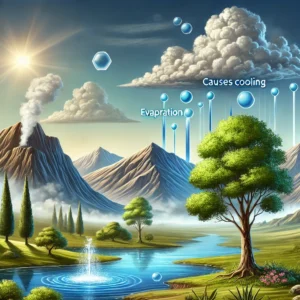Evaporation is a fascinating process that plays a crucial role in our everyday lives, from cooling our bodies through sweat to influencing the climate. But have you ever wondered why evaporation causes cooling? Let’s explore the science behind this phenomenon in a simple way.
The Science Behind Evaporation and Cooling
When a liquid, like water, evaporates, it transitions from a liquid state to a gaseous state. This process requires energy, specifically heat energy. Here’s how it works:
- Molecular Motion: In any liquid, the molecules are in constant motion, with some moving faster (having more energy) and some moving slower (having less energy).
- Evaporation Process: The fastest-moving (most energetic) molecules have enough energy to break free from the liquid’s surface and escape into the air as vapor.
- Energy Loss: As these high-energy molecules leave, the average energy of the remaining molecules decreases. Since temperature is directly related to the average kinetic energy of molecules, this loss of high-energy molecules results in a decrease in temperature.
- Cooling Effect: This decrease in temperature is what we experience as cooling. It’s why sweat cools your skin as it evaporates: the high-energy water molecules leave, taking heat with them, and leaving the surface cooler.

Everyday Examples
- Sweating: When you exercise or get hot, your body produces sweat. As this sweat evaporates from your skin, it takes away heat, cooling your body down.
- Evaporation of Water: A puddle of water on a warm day will slowly evaporate, and if you touch the surface of the water, it feels cooler than the air around it.
Conclusion
Evaporation is not just a simple transition from liquid to gas; it’s a powerful cooling mechanism that affects everything from our bodies to the environment. The next time you feel the cool breeze on a hot day or notice a puddle drying up, you’ll know the science behind the cooling effect of evaporation.